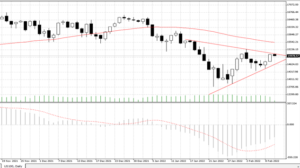

10.02.2022 – A rumour is pulling Wall Street up. JP Morgan spread the word that the official US inflation rate will be much milder than expected. In other words: the figures will probably be fudged. For traders, it will be exciting on Thursday afternoon, from 2.30 p.m. we will know what the next move will be – then the new Consumer Price Index (CPI) will be on the table.
The forecast for the CPI stands at 7.2 per cent. If the inflation rate is actually below that and thus confirms the floor whispers, then we will probably see a short-term bull market. Especially since the head of the Federal Reserve in Cleveland, Loretta J. Mester, also poured gasoline on the fire. She said “long-run inflation expectations are still well anchored”. Hear, hear, that sounds like the now long-cancelled statement that the Fed sees inflation only as a transitory phenomenon. With this, a sharp tapering suddenly seems to be called into question.
The result: bonds, equities, crude, copper, cryptos – everything headed north. The situation in the Nasdaq 100 is particularly interesting – here a triangle has formed in the daily chart, soon it will be up or down; the index is also a little below the red 50-day line, which should actually magically attract prices. Especially as the MACD in the picture below still has some room to rise. Since growth stocks react particularly strongly to waning interest rate fantasies, the best trades should be possible here.

Source: Bernstein Bank GmbH
Revision every two years
This brings us to the fundamental news. It is a fact that Joe Biden’s ratings have meanwhile dipped in mirror image to the inflation rate. It is also a fact that the Bureau of Labor Statistics (BLS) actually revises the CPI every two years. The last time the data from the Consumer Expenditure Survey was refreshed was in January 2020. Now, for the first time, figures from 2019 to 2020 will be included; prices from 2017 to 2018 will be dropped. In other words, the basis for comparison will be raised because more goods will be included that have already become more expensive in the recent past. And thus the percentage jump compared to today will probably be less dramatic.
Reweighting of prices
In addition, the index will be remeasured. A small example: according to the OLS, teaching materials for schools will receive 0.2 per cent more weight; but the share of rent will drop by 0.3 per cent. Do you notice anything? A good that not everyone needs and therefore hardly notices is weighted more heavily; exploding rent costs, which affect quite a few, are adjusted downwards. In addition, as always in January, seasonal factors are included – and this is pure numbers voodoo. The financial blog ZeroHedge scoffed that the labour market figures had also been tricked with a magical “seasonal adjustment”.
The matter is certainly a factor for traders. The Economics team at Goldman Sachs, at any rate, pointed out yesterday that the topic has reached its own clients: “ahead of tomorrow’s CPI release, many clients have asked how the biennial change in category weights and annual seasonal factor update will affect inflation in January and the remainder of 2022.”
Megasqueeze
With all these considerations, Wall Street has done a 180-degree about-face. Whereas just a few days ago there was talk of an “Endgame”, now there is talk of a mega-shortsqueeze. Another team at Goldman Sachs, for example, just noted that short sales at hedge funds are outpacing long buys by 2.7 to 1 in dollar terms year over year. On GS Prime, it said short sales have risen for six straight weeks, with short flow since New Year’s Eve the highest in ten years. North America is the most shorted region at 81 per cent, it said. Liz Ann Sonders, Chief Investment Officer at Schwab, therefore also sees a reduced risk to the downside.
Our conclusion: We see a high chance that the figures are being fudged for political reasons. However, you never know. Those who want to trade the matter and assume that the prices will shoot vertically up or down should consider a straddle, i.e. a combination of put and call with tight stops. Bernstein Bank wishes you good luck!
Important Notes on This Publication:
The content of this publication is for general information purposes only. In this context, it is neither an individual investment recommendation or advice nor an offer to purchase or sell securities or other financial products. The content in question and all the information contained therein do not in any way replace individual investor- or investment-oriented advice. No reliable forecast or indication for the future is possible with respect to any presentation or information on the present or past performance of the relevant underlying assets. All information and data presented in this publication are based on reliable sources. However, Bernstein Bank does not guarantee that the information and data contained in this publication is up-to-date, correct and complete. Securities traded on the financial markets are subject to price fluctuations. A contract for difference (CFD) is also a financial instrument with leverage effect. Against this backdrop, CFD trading involves a high risk up to the point of total loss and may not be suitable for all investors. Therefore, make sure that you have fully understood all the correlating risks. If necessary, ask for independent advice. CFDs are complex instruments and are associated with the high risk of losing money quickly because of the leverage effect. 68% of retail investor accounts lose money trading CFD with this provider. You should consider whether you understand how CFD work and whether you can afford to take the high risk of losing your money.
